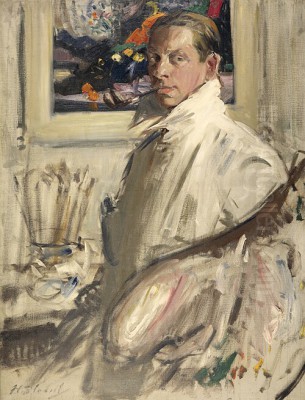
Francis Campbell Boileau Cadell stands as one of the most distinctive and celebrated figures in early 20th-century Scottish art. Born into the vibrant cultural milieu of Edinburgh, he rose to prominence as a core member of the group posthumously known as the Scottish Colourists. Alongside Samuel John Peploe, John Duncan Fergusson, and George Leslie Hunter, Cadell forged a path that brought the revolutionary colour and light of French Post-Impressionism and Fauvism into a uniquely Scottish context. His work, characterized by its elegance, bold design, and luminous palette, continues to captivate audiences today.
Cadell's journey was one of early promise, European immersion, and a lifelong dedication to capturing the effects of light, whether on the starkly beautiful landscapes of the Hebridean island of Iona or within the sophisticated interiors of Edinburgh's New Town. His art evolved significantly throughout his career, yet maintained a consistent thread of stylishness and a masterful command of colour and composition. This exploration delves into the life, artistic development, key works, and enduring legacy of F.C.B. Cadell, a painter whose vision remains remarkably fresh and vital.
Early Life and Artistic Awakening
Francis Campbell Boileau Cadell was born in Edinburgh on April 12, 1883. His background was one of relative privilege; his father, also named Francis Cadell, was a respected surgeon, and his mother, Mary Hamilton Boileau, came from a family with notable connections. This comfortable upbringing likely provided the young Cadell with the security and encouragement to pursue his burgeoning artistic interests from an early age. He displayed a natural talent for drawing, suggesting a predisposition towards the visual arts that would define his life.
Recognizing his potential, Cadell's family supported his decision to pursue formal art training abroad. At the remarkably young age of 16, in 1899, he travelled to Paris, the undisputed centre of the art world at the turn of the century. This move was pivotal. Paris was a crucible of artistic innovation, still reverberating from the impact of Impressionism and witnessing the birth of radical new movements. Enrolling at the prestigious Académie Julian, Cadell immersed himself in this stimulating environment.
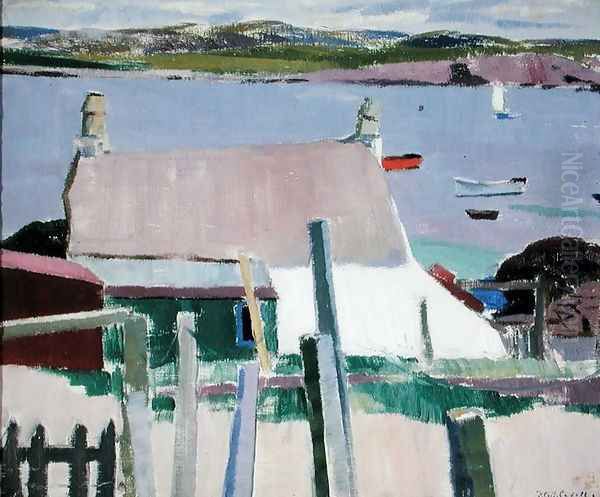
The Académie Julian was a popular destination for international students, known for its less rigid structure compared to the official École des Beaux-Arts. Here, Cadell would have received instruction grounded in traditional drawing techniques but would also have been exposed to the currents of modern art swirling through the city's galleries and studios. It was in Paris that he encountered the works that would shape his early development, particularly those of the Impressionists and their immediate successors.
Parisian Influences and Early Friendships
Cadell's time in Paris (initially from 1899 to 1902, with later visits) was transformative. He absorbed the lessons of Impressionism, particularly the emphasis on capturing fleeting moments, the effects of light, and the use of a brighter palette. However, he was perhaps more profoundly influenced by artists who built upon or reacted against Impressionism. The elegant compositions, modern subject matter, and sometimes stark tonal contrasts found in the work of Édouard Manet clearly resonated with him, as did the aesthetic sensibilities and tonal harmonies of the American expatriate James McNeill Whistler. Whistler's sophisticated arrangements and emphasis on "art for art's sake" would echo in Cadell's later interior scenes.
Crucially, it was during his studies at the Académie Julian that Cadell met fellow Scot Samuel John Peploe. Peploe, slightly older and already developing his own distinct style, became a close and lifelong friend. Their shared experiences in Paris, mutual admiration for French painting, and ongoing artistic dialogue proved immensely fruitful for both artists. They would often travel and exhibit together, pushing each other to experiment and refine their approaches to colour and form.
Beyond Manet and Whistler, the burgeoning Fauvist movement, led by Henri Matisse and André Derain, made a significant impact. While Cadell never fully embraced the raw, untamed expressionism of the Fauves, their liberation of colour from purely descriptive purposes undoubtedly encouraged his own increasingly bold and non-naturalistic use of pigment. The structural concerns of Paul Cézanne and the expressive intensity of Vincent van Gogh also filtered into his artistic consciousness, contributing to the complex blend of influences that shaped his unique vision.
Munich and the Consolidation of Style
After his initial period in Paris, Cadell sought further training and exposure, travelling to Munich in 1906. Germany, particularly Munich and Dresden, was also a centre for artistic innovation at this time, with movements like Die Brücke (The Bridge) forming. While perhaps less directly influential on his core style than Paris, the Munich experience broadened his horizons and likely reinforced his commitment to modernism. He continued to refine his technique and exhibit his work, participating in shows in Munich.
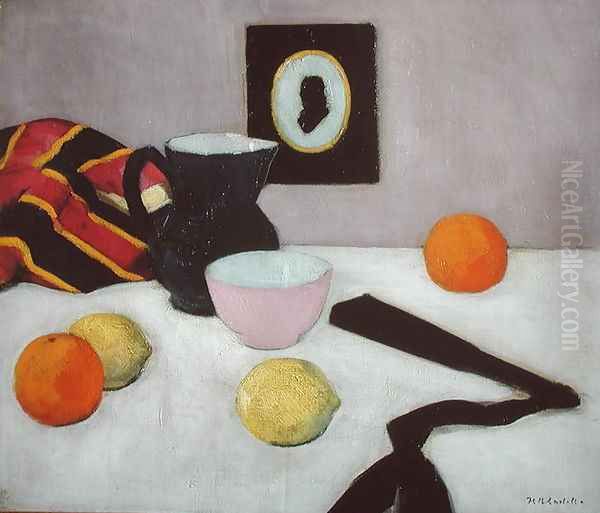
Upon returning to Scotland, Cadell established himself in Edinburgh, setting up a studio in the city's elegant New Town. His early works from this period often featured sophisticated portraits of women, rendered with a fluid brushwork and a sensitivity to tone that recalled Whistler and Manet. These paintings, often set against dark backgrounds, highlighted the fashionable attire of his sitters and quickly gained him recognition. He held his first solo exhibition at Doig, Wilson & Wheatley's gallery in Edinburgh in 1908, marking his official arrival on the Scottish art scene. A trip to Venice in 1910 further stimulated his interest in light and colour, resulting in works that showed a brighter palette and a more overtly Impressionistic handling, paying homage to the city's unique atmosphere.
The Allure of Iona: A Defining Muse
A significant turning point in Cadell's artistic development came with his discovery of the island of Iona, located off the west coast of Scotland in the Inner Hebrides. He first visited the island, often in the company of Samuel Peploe, around 1912. Iona, with its ancient religious history, white sandy beaches, turquoise waters, and dramatic views towards the Isle of Mull, captivated him immediately. The quality of light on the island – clear, bright, and often dramatically shifting – proved an enduring source of inspiration.
From 1912 onwards, Cadell returned to Iona almost every summer for the next two decades. The island became central to his artistic output, arguably the landscape with which he is most closely associated. His Iona paintings mark a distinct shift towards the high-keyed palette and simplified forms that characterize his mature Colourist style. He sought to capture the intense blues of the sea and sky, the stark white of the beaches and cottages, and the distinctive shapes of the landscape, often including the imposing silhouette of Ben More on Mull in the distance.
In works like Iona, Towards Mull or Iona North East and Ben More, Mull, Cadell employed flat planes of vibrant colour, often outlined with bold strokes, reducing the landscape to its essential elements. He used creamy, often thickly applied paint (impasto) to convey the texture and brilliance of the scene. His focus was less on topographical accuracy and more on capturing the emotional and visual impact of the light and colour specific to that location. The Iona paintings represent a high point of Scottish Colourism, showcasing Cadell's ability to translate the intensity of the Hebridean light into pure, exhilarating paint.
War Service and Artistic Interruption

The outbreak of the First World War in 1914 interrupted Cadell's burgeoning career. Initially, he attempted to enlist but was rejected on health grounds. Determined to serve, he reportedly undertook physical work on a farm to improve his fitness and was eventually accepted into the army. Sources suggest he served initially with the 9th Royal Scots and later with the 5th Battalion, Argyll and Sutherland Highlanders. He was the only one of the four core Scottish Colourists to see active service.
His time in the trenches inevitably impacted him, though he continued to sketch when possible. These wartime drawings, capturing the realities of military life, possess a directness and immediacy distinct from his pre-war work. They provided raw material and inspiration, not only for some of his own later pieces but also reportedly for the "Jack and Tommy" series created by his friend, the artist James Gibson. The war years represented a significant hiatus in his painting career, but the experience may have contributed to the increased boldness and perhaps a certain simplification evident in his post-war work.
Post-War Flourishing: Interiors and Still Lifes
Returning to Edinburgh after the war, Cadell entered a period of renewed artistic activity and stylistic consolidation. He moved into a new studio at 6 Ainslie Place in the New Town, which he famously decorated in a bold, modern style with dove-grey walls, black floors, and vibrant orange and blue accents. This carefully curated environment became the setting for many of his most iconic interior paintings and still lifes. His work from the 1920s is often considered the peak of his Colourist phase, characterized by dazzling colour, confident design, and a sophisticated elegance.
Cadell became particularly known for his interior scenes, often featuring female figures, arrangements of objects, and reflections. He frequently incorporated mirrors into his compositions, using them not just as decorative elements but as devices to create spatial complexity, multiply viewpoints, and amplify the play of light. Works like The Black Fan, The White Sofa, and Nude reflected in a mirror (also known as Nude Seated on a Sofa) exemplify this fascination. The reflections fracture and reassemble the space, adding layers of visual interest and demonstrating Cadell's masterful control over composition. His long-term partner, Charles Oliver, sometimes appeared as a model in these works.
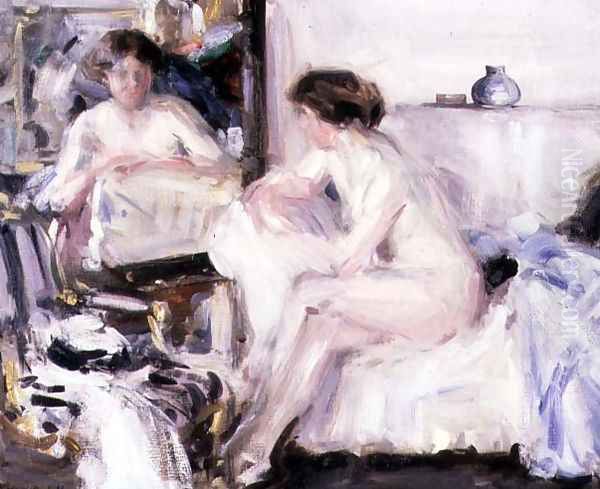
Still life also remained a vital genre for Cadell. He painted arrangements of flowers, ceramics, fans, and other objects with the same vibrant palette and bold design sense he applied to his interiors and landscapes. Tulips (c. 1920) and Pink Carnations showcase his ability to translate the delicate forms of flowers into dynamic compositions of pure colour, often applying paint thickly and juxtaposing complementary hues to create a shimmering effect. These works reveal the ongoing influence of French Post-Impressionism, particularly the Fauvist delight in colour and, in their structural arrangement, a nod to Cézanne. Other artists exploring vibrant still life at the time included French painters like Pierre Bonnard and Édouard Vuillard of the Nabis group, though Cadell's approach retained a distinct graphic clarity.
The Scottish Colourists: A Shared Vision
While Cadell, Peploe, Fergusson, and Hunter never formed a society or issued a manifesto, they are grouped together as the Scottish Colourists due to their shared artistic concerns and their collective role in introducing modern French art principles to Scotland. All four spent formative time in France and were deeply impressed by the Impressionists, Post-Impressionists (especially Cézanne, Van Gogh, Gauguin), and the Fauves (particularly Matisse). They shared a commitment to exploring the expressive potential of colour and light, moving beyond naturalistic representation.
Despite these shared interests, each artist retained a distinct personality. Peploe, Cadell's closest associate, often focused on tightly structured compositions, particularly in his still lifes, revealing a deep engagement with Cézanne. Fergusson, who spent much of his career in France, embraced a more dynamic and sometimes overtly sensual style, often depicting figures and scenes of modern life. Hunter, largely self-taught, possessed a more intuitive and raw approach to colour and form.
Cadell's contribution is often defined by his inherent elegance, his strong sense of design, and his particular sensitivity to the interplay of light and reflection. His work, especially from the 1920s, often has a graphic quality, with flat areas of bold colour contained within strong outlines. The group exhibited together, notably at the Leicester Galleries in London in the 1920s, which helped solidify their identity in the public eye, supported by dealers like Alexander Reid in Glasgow. Their collective impact significantly shifted the direction of Scottish painting in the early 20th century, moving it away from the more muted palettes of predecessors like the Glasgow Boys (such as James Guthrie or E.A. Hornel) and earlier landscape painters like William McTaggart.
Later Years, Recognition, and Legacy
Cadell's artistic achievements gained formal recognition during his lifetime. He was elected an Associate of the Royal Scottish Academy (ARSA) in 1931 and became a full Academician (RSA) in 1936. He had been a member of the Royal Scottish Society of Painters in Watercolour (RSW) since 1905 and was also involved with the Society of Scottish Artists. His work continued to be exhibited regularly in Scotland and London.
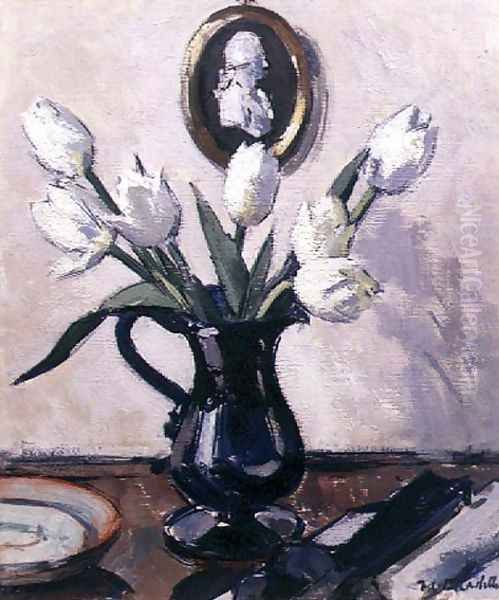
However, the later years of his life were marked by challenges. The Wall Street Crash of 1929 and the ensuing Great Depression had a severe impact on the art market. Patronage dwindled, and Cadell, who relied on sales to maintain his relatively comfortable lifestyle, faced financial difficulties. Some critics suggest this period saw a slight shift in his style, perhaps a move towards thinner paint application and slightly more subdued tones, possibly driven by economic necessity as much as artistic evolution. His health also began to decline.
Francis Campbell Boileau Cadell died in Edinburgh on December 6, 1937, at the age of 54. Despite his relatively short life, he left behind a significant body of work that cemented his reputation as a major figure in Scottish art. His paintings are held in numerous public collections, including the National Galleries of Scotland, Glasgow Museums, the Hunterian Art Gallery at the University of Glasgow, Aberdeen Art Gallery, and the Tate in London.
His legacy endures through the continued appreciation of his work. Cadell's paintings remain highly sought after by collectors, frequently achieving substantial prices at auction. Works like Iona North towards Mull and Nude reflected in a mirror command significant attention when they appear on the market, testament to their enduring appeal and historical importance. He is remembered for his unique ability to blend Parisian modernism with a Scottish sensibility, creating works that are both sophisticated and deeply felt, full of light, colour, and an unmistakable sense of style.
Conclusion: An Enduring Vision of Colour and Light
Francis Campbell Boileau Cadell's contribution to Scottish art is undeniable. As a key member of the Scottish Colourists, he played a vital role in bringing the innovations of early 20th-century French painting to a British audience, translating the radical use of colour and light pioneered by artists like Matisse into his own elegant and distinctive idiom. From his early Whistlerian portraits to the vibrant landscapes of Iona and the dazzling interiors of his Edinburgh studio, Cadell's work consistently demonstrates a masterful command of design, a sophisticated understanding of colour theory, and an unerring eye for the effects of light.
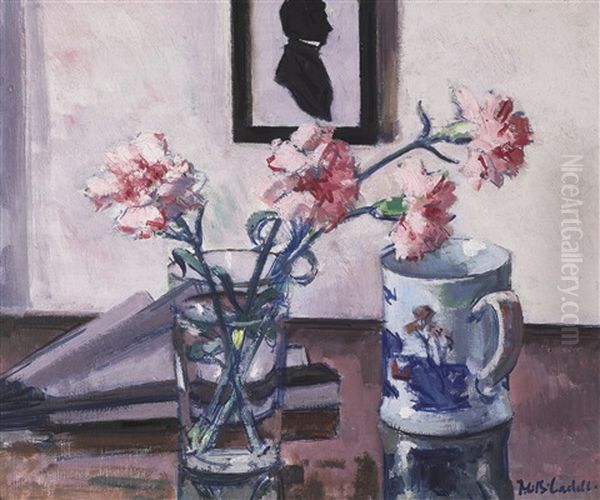
His paintings offer a world of refined elegance, yet one charged with the energy of bold colour and dynamic composition. Whether capturing the stark beauty of the Hebrides or the chic atmosphere of the New Town, Cadell infused his subjects with a vitality and luminosity that remains compelling. His exploration of reflections, his confident brushwork, and his celebratory use of pigment mark him as a unique talent. Though his life was cut short, F.C.B. Cadell left an indelible mark on Scottish art history, and his paintings continue to shine as testaments to a singular artistic vision.